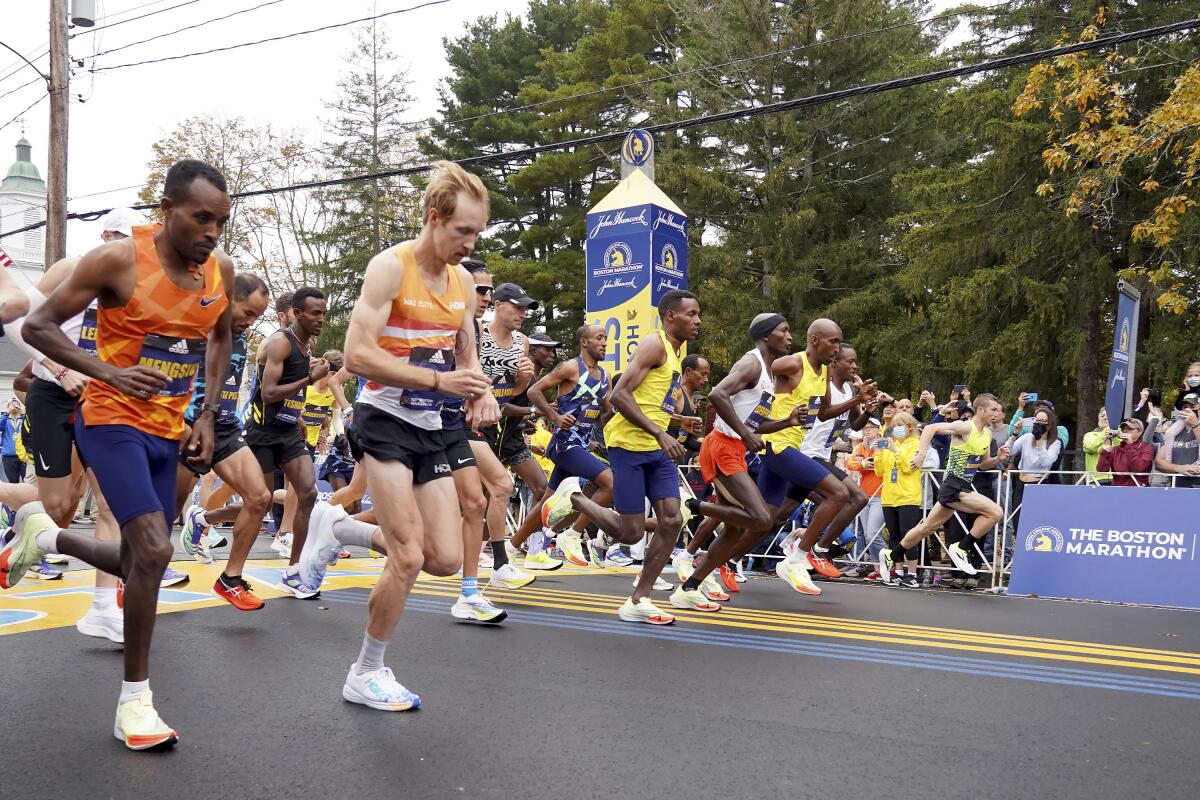Benson Kipruto and Diana Kipyogei provide a Kenyan sweep at 125th Boston Marathon

- Share via
BOSTON — Kenya’s Benson Kipruto won the pandemic-delayed Boston Marathon on Monday when the race returned from a 30-month absence with a smaller, socially distanced feel and moved from the spring for the first time in its 125-year history.
Although organizers put runners through COVID-19 protocols and asked spectators to keep their distance, large crowds lined the 26.2-mile course from Hopkinton to Boston as an early drizzle cleared and temperatures rose to the low 60s for a beautiful fall day.
They watched Kipruto run away from the lead pack as it turned onto Beacon Street with about three miles to go and break the tape in 2 hours 9 minutes 51 seconds. Diana Kipyogei won the women’s race to complete the eighth Kenyan sweep since 2000.
A winner in Prague and Athens who finished 10th in Boston in 2019, Kipruto waited out an early breakaway by American CJ Albertson, who led by as many as two minutes at the halfway point. Kipruto took the lead at Cleveland Circle and finished 46 seconds ahead of 2016 winner Lemi Berhanu; Albertson, who turned 28 on Monday, was 10th, 1:53 back.
Kipyogei ran ahead for much of the race and finished in 2:24:45, 23 seconds ahead of 2017 winner Edna Kiplagat.
With fall foliage replacing spring daffodils and more masks than Mylar blankets, the pandemic-delayed marathon finally got underway with some of the world’s best runners.
A rolling start and shrunken field allowed for social distancing on the course, as organizers tried to manage amid a changing COVID-19 pandemic that forced them to cancel the race last year for the first time since the event began in 1897.
“It’s a great feeling to be out on the road,” race director Dave McGillivray said. “Everyone is excited. We’re looking forward to a good day.”
A light rain greeted participants at the starting line in Hopkinton, where about 30 uniformed members of the Massachusetts National Guard left at 6 a.m. The men’s and women’s wheelchair racers — some of whom completed the 26.2-mile distance in Chicago a day earlier — were followed by the men’s and women’s professional fields. The course ends in Boston’s Copley Square.
“We took things for granted before COVID-19. It’s great to get back to the community, and it puts things in perspective,” said National Guard Capt. Greg Davis, 39, who was walking with the military group for the fourth time. “This is a historic race, but today is a historic day.”
Kenya’s Lawrence Cherono and Worknesh Degefa of Ethiopia did not return to defend their 2019 titles, but 13 past champions and five Tokyo Paralympic gold-medal winners were in the professional fields.
Held annually since a group of Bostonians returned from the 1896 Athens Olympics and decided to stage a marathon of their own, the race has been held during world wars and even the 1918 Spanish flu pandemic. But it was postponed and then canceled last year, and then postponed again from spring.
It’s the first time the event hasn’t been held in April as part of the Patriots’ Day holiday that commemorates the start of the Revolutionary War. To recognize Indigenous Peoples Day, race organizers honored 1936 and ’39 winner Ellison “Tarzan” Brown and three-time runner-up Patti Catalano Dillon, a member of the Mi’kmaq tribe.
To check the spread of the coronavirus, runners had to show proof of vaccination or test negative for COVID-19. Organizers also re-engineered the start so that runners in the recreational field of more than 18,000 weren’t waiting around in crowded corrals for their wave to begin; instead, once they got off the bus in Hopkinton they were able to start running.
“I love that we’re back to races across the country and the world,” said Doug Flannery, a 56-year-old Illinois resident who was waiting to start his sixth Boston Marathon. “It gives people hope that things are starting to come back.”
Police were visible all along the course as authorities vowed to remain vigilant eight years after the bombings that killed three spectators and maimed hundreds of others on Boylston Street near the Back Bay finish line.
But the crowds lining the course as it wends through eight cities and towns were expected to be smaller than in past years. Wellesley College students have been told not to kiss the runners as they pass the school’s iconic “scream tunnel” near the halfway mark.
More to Read
Sign up for Essential California
The most important California stories and recommendations in your inbox every morning.
You may occasionally receive promotional content from the Los Angeles Times.













